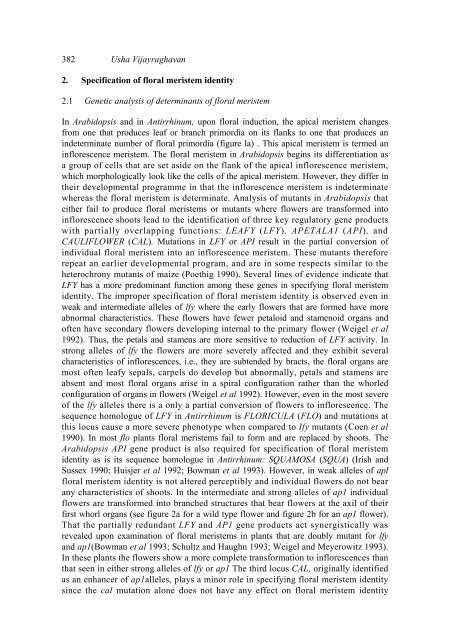Genetic regulation of flower development - Indian Academy of ...
Genetic regulation of flower development - Indian Academy of ...
Genetic regulation of flower development - Indian Academy of ...
You also want an ePaper? Increase the reach of your titles
YUMPU automatically turns print PDFs into web optimized ePapers that Google loves.
382 Usha Vijayraghavan<br />
2. Specification <strong>of</strong> floral meristem identity<br />
2.1 <strong>Genetic</strong> analysis <strong>of</strong> determinants <strong>of</strong> floral meristem<br />
In Arabidopsis and in Antirrhinum, upon floral induction, the apical meristem changes<br />
from one that produces leaf or branch primordia on its flanks to one that produces an<br />
indeterminate number <strong>of</strong> floral primordia (figure la) . This apical meristem is termed an<br />
inflorescence meristem. The floral meristem in Arabidopsis begins its differentiation as<br />
a group <strong>of</strong> cells that are set aside on the flank <strong>of</strong> the apical inflorescence meristem,<br />
which morphologically look like the cells <strong>of</strong> the apical meristem. However, they differ in<br />
their <strong>development</strong>al programme in that the inflorescence meristem is indeterminate<br />
whereas the floral meristem is determinate. Analysis <strong>of</strong> mutants in Arabidopsis that<br />
either fail to produce floral meristems or mutants where <strong>flower</strong>s are transformed into<br />
inflorescence shoots lead to the identification <strong>of</strong> three key regulatory gene products<br />
with partially overlapping functions: LEAFY (LFY), APETALA1 (API), and<br />
CAULIFLOWER (CAL). Mutations in LFY or API result in the partial conversion <strong>of</strong><br />
individual floral meristem into an inflorescence meristem. These mutants therefore<br />
repeat an earlier <strong>development</strong>al program, and are in some respects similar to the<br />
heterochrony mutants <strong>of</strong> maize (Poethig 1990). Several lines <strong>of</strong> evidence indicate that<br />
LFΥ has a more predominant function among these genes in specifying floral meristem<br />
identity. The improper specification <strong>of</strong> floral meristem identity is observed even in<br />
weak and intermediate alleles <strong>of</strong> lfy where the early <strong>flower</strong>s that are formed have more<br />
abnormal characteristics. These <strong>flower</strong>s have fewer petaloid and stamenoid organs and<br />
<strong>of</strong>ten have secondary <strong>flower</strong>s developing internal to the primary <strong>flower</strong> (Weigel et al<br />
1992). Thus, the petals and stamens are more sensitive to reduction <strong>of</strong> LFY activity. In<br />
strong alleles <strong>of</strong> lfy the <strong>flower</strong>s are more severely affected and they exhibit several<br />
characteristics <strong>of</strong> inflorescences, i.e., they are subtended by bracts, the floral organs are<br />
most <strong>of</strong>ten leafy sepals, carpels do develop but abnormally, petals and stamens are<br />
absent and most floral organs arise in a spiral configuration rather than the whorled<br />
configuration <strong>of</strong> organs in <strong>flower</strong>s (Weigel et al 1992). However, even in the most severe<br />
<strong>of</strong> the lfy alleles there is a only a partial conversion <strong>of</strong> <strong>flower</strong>s to inflorescence. The<br />
sequence homologue <strong>of</strong> LFY in Antirrhinum is FLORICULA (FLO) and mutations at<br />
this locus cause a more severe phenotype when compared to Ify mutants (Coen et al<br />
1990). In most flo plants floral meristems fail to form and are replaced by shoots. The<br />
Arabidopsis API gene product is also required for specification <strong>of</strong> floral meristem<br />
identity as is its sequence homologue in Antirrhinum: SQUAMOSA (SQUA) (Irish and<br />
Sussex 1990; Huisjer et al 1992; Bowman et al 1993). However, in weak alleles <strong>of</strong> apl<br />
floral meristem identity is not altered perceptibly and individual <strong>flower</strong>s do not bear<br />
any characteristics <strong>of</strong> shoots. In the intermediate and strong alleles <strong>of</strong> ap1 individual<br />
<strong>flower</strong>s are transformed into branched structures that bear <strong>flower</strong>s at the axil <strong>of</strong> their<br />
first whorl organs (see figure 2a for a wild type <strong>flower</strong> and figure 2b for an ap1 <strong>flower</strong>).<br />
That the partially redundant LFY and AP1 gene products act synergistically was<br />
revealed upon examination <strong>of</strong> floral meristems in plants that are doubly mutant for lfy<br />
and ap1(Bowman et al 1993; Schultz and Haughn 1993; Weigel and Meyerowitz 1993).<br />
In these plants the <strong>flower</strong>s show a more complete transformation to inflorescences than<br />
that seen in either strong alleles <strong>of</strong> lfy or ap1 The third locus CAL, originally identified<br />
as an enhancer <strong>of</strong> ap1alleles, plays a minor role in specifying floral meristem identity<br />
since the cal mutation alone does not have any effect on floral meristem identity

















